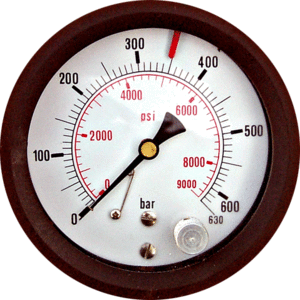Difference between revisions of "Pressure Gauges"
(Created page with "Category:Meters, Gauges{{Knoppen}} <noinclude><!------------------------------------------------ * READ THIS FIRST * Only edit this page if you can improve the content. ...") |
|||
| Line 7: | Line 7: | ||
* Please start editing this page after the /noinclude | * Please start editing this page after the /noinclude | ||
* -------------------------------------------------></noinclude> | * -------------------------------------------------></noinclude> | ||
[[File:Pressure gauge.gif|thumb|right|Pressure Gauges]] | |||
'''Pressure Gauge''' is an instrument that measures the pressure in a vessel, a line, or whatever the pressure gauge is connected to. Pressure gauges come in at least two different types: differential pressure gauges, and absolute pressure gauges. | |||
Differential pressure gauges measure difference in pressure. Pressure gauges that read zero when not attached to anything would actually be differential gauges that measure the difference between atmospheric pressure and the pressure of whatever they are attached to. Vacuum gauges are differential gauges that measure how far below atmospheric pressure the pressure is in a vessel or pipe. Gauges that measure gauge pressure are just differential gauges that are calibrated to measure zero at atmospheric pressure. | |||
Absolute pressure gauges would only read zero if they were attached to an absolute vacuum. A common type of absolute pressure gauge is a barometer.A mercury barometer is really a differential gauge that measures the difference between the vapor pressure of the mercury and the surrounding atmosphere, but the vapor pressure of the mercury is so low that the error in treating it as an absolute pressure gauge is generally negligible. | |||
Latest revision as of 23:26, 26 December 2012
Pressure Gauge is an instrument that measures the pressure in a vessel, a line, or whatever the pressure gauge is connected to. Pressure gauges come in at least two different types: differential pressure gauges, and absolute pressure gauges.
Differential pressure gauges measure difference in pressure. Pressure gauges that read zero when not attached to anything would actually be differential gauges that measure the difference between atmospheric pressure and the pressure of whatever they are attached to. Vacuum gauges are differential gauges that measure how far below atmospheric pressure the pressure is in a vessel or pipe. Gauges that measure gauge pressure are just differential gauges that are calibrated to measure zero at atmospheric pressure.
Absolute pressure gauges would only read zero if they were attached to an absolute vacuum. A common type of absolute pressure gauge is a barometer.A mercury barometer is really a differential gauge that measures the difference between the vapor pressure of the mercury and the surrounding atmosphere, but the vapor pressure of the mercury is so low that the error in treating it as an absolute pressure gauge is generally negligible.
